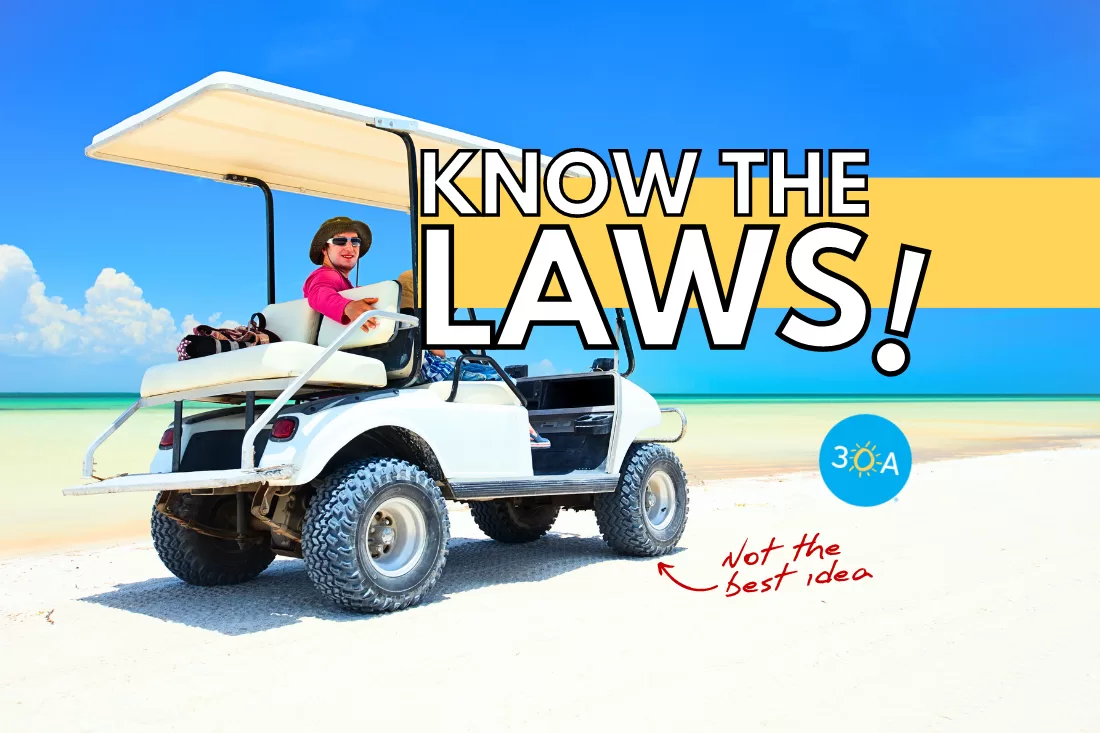Golf Carts in South Walton: What You Need to Know
It's golf cart season! Here's everything you need to know about golf carts in South Walton.
It's golf cart season! Here's everything you need to know about golf carts in South Walton.

Golf carts. They’re increasingly a part of our daily life in South Walton. From vacationing tourists to second homeowners to long-time locals, more and more people turn to these convenient and environmentally-friendly modes of transport for short excursions. And while electric vehicles are much better for the environment, they can also pose a safety hazard when blended into traffic along with SUVs and higher-speed automobiles.
So comes confusion and questions about exactly where golf carts can be driven, what the laws and rules are, and how to operate them safely. We’ve heard your questions and we wanted answers too, so we went straight to the source: Our Walton County Sheriff’s Office. Lt. Scott Hogeboom was happy to give us the scoop.
According to Walton County Sheriff’s Office, section 320.01(41), Florida Statutes, defines low-speed vehicles (LSVs) as “any four-wheeled vehicle whose top speed is greater than 20 miles per hour, but not greater than 25 miles per hour.”
LSVs must be registered, titled, and insured with personal injury protection (PIP) and property damage liability (PDL) insurance. Any person operating an LSV must have a valid driver’s license in their immediate possession.
Golf carts can be driven on any county-maintained road as long as the speed limit is 35 miles per hour or less.
“Golf carts would impede on traffic if they drove on higher speed roads,” said Hogeboom. “The cart would not be able to keep up and any higher speed would be unsafe.”
Low-speed vehicles are NOT allowed on Highway 98.
Child restraints and car seats are required for all children traveling in low-speed vehicles. Low-speed vehicles are prohibited from driving on any part of Highway 98 (including the shoulder) but may cross at fixed intersections with traffic lights. They also may not drive on sidewalks, utility paths, and/or bike paths. Below is a map illustrating which roads are prohibited for low-speed vehicles.
Check out this interactive map, which shows which roads are prohibited for low-speed vehicles. Roads prohibited to low-speed vehicles are highlighted in red. When traveling on roadways permissible for low-speed vehicles, please pull over to the side of the road to allow cars to pass if you notice that traffic is beginning to back up behind you.
The driver must be 16 years old or older and licensed, just like any car.
This point could be the source of some confusion for people. Some communities, like Blue Mountain Beach or Inlet Beach, have county-maintained roads and must follow county and state laws. But private resort communities like Seaside, Alys Beach, Rosemary Beach, and Sandestin, for example, have private roads, which are not maintained by the county, and therefore have their own set of regulations.
“These communities decide their own rules, since they are private,” said Hogeboom. “but when people drive from the communities out on to the county roads, they must go by the Florida statutes and county ordinances.”
How do you know if you’re on a private road or a public street? There’s a simple trick to knowing for sure:
Any road with a GREEN street sign is a county-maintained road, while any road with a BLUE street sign is privately maintained.

No, golf carts are NOT allowed on any of the multi-use paths in South Walton. NOTE: True golf carts are not street legal, although they can be converted into recognized “low-speed vehicles” with the addition of the noted equipment and a tag.
The golf cart must be equipped with the following:
• Headlamps
• Front and rear turn signals
• Stop lamps
• Tail lamps
• Reflex reflectors, red – one on each side and one on the rear
• Exterior mirror on the driver’s side and an interior rear-view mirror or exterior mirror on the passenger side
• Parking brake
• Windshield
• Seat belt for each designated seat
• Vehicle identification number (VIN)

